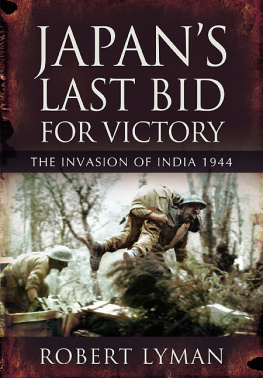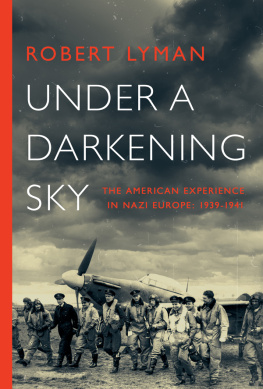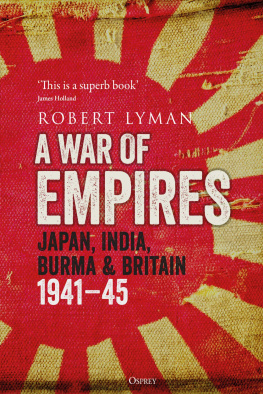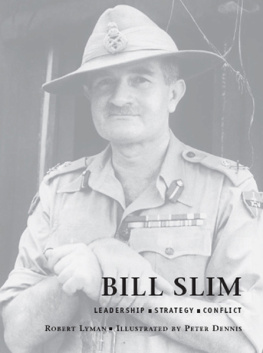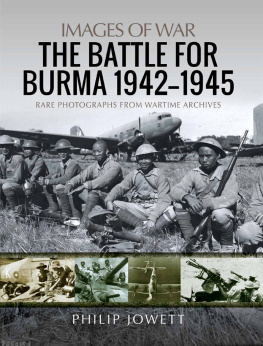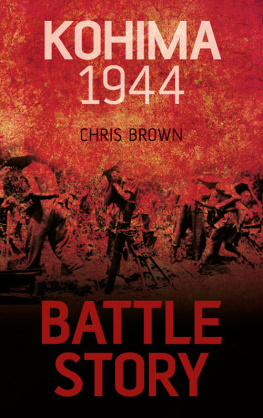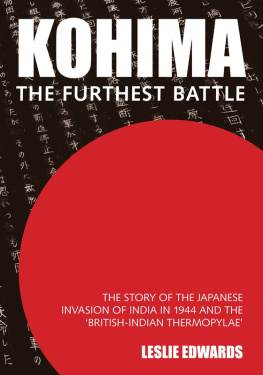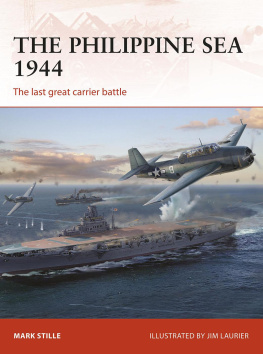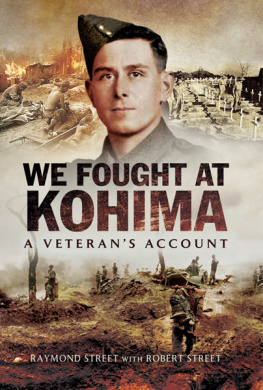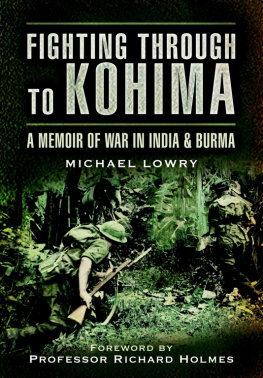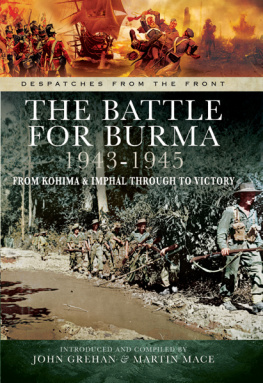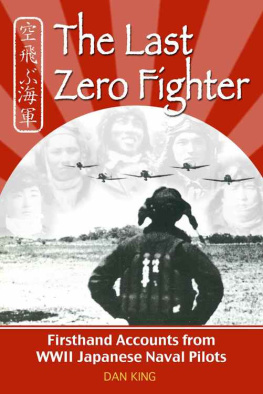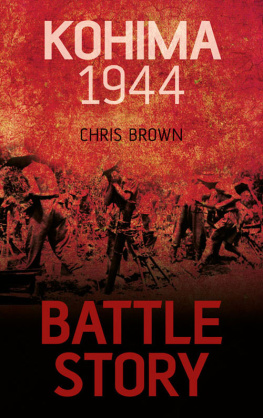First Published in Great Britain in 2011 by
The Praetorian Press
an imprint of
Pen & Sword Books Ltd
47 Church Street
Barnsley
South Yorkshire
S70 2AS
Copyright Robert Lyman, 2011
ISBN: 978 1 84884 542 8
ePub ISBN: 9781848849464
PRC ISBN: 9781848849471
The right of Robert Lyman to be identified as the
author of this work has been asserted by him in accordance
with the Copyright, Designs and Patents Act 1988
A CIP catalogue record for this book is
available from the British Library
All rights reserved. No part of this book may be reproduced or transmitted
in any form or by any means, electronic or mechanical including
photocopying, recording or by any information storage and retrieval
system, without permission from the Publisher in writing.
Typeset in Ehrhardt
by Chic Media Ltd
Printed and bound in England
by CPI
Pen & Sword Books Ltd incorporates the imprints of
Pen & Sword Books Ltd incorporates the imprints of
Pen & Sword Aviation, Pen & Sword Family History, Pen & Sword Maritime,
Pen & Sword Military, Pen & Sword Discovery, Wharncliffe Local History,
Wharncliffe True Crime, Wharncliffe Transport, Pen & Sword Select,
Pen & Sword Military Classics, Leo Cooper, Remember When,
The Praetorian Press, Seaforth Publishing and Frontline Publishing
For a complete list of Pen & Sword titles please contact
PEN & SWORD BOOKS LIMITED
47 Church Street, Barnsley, South Yorkshire, S70 2AS, England
E-mail:
Website: www.pen-and-sword.co.uk
Also by Robert Lyman
Slim, Master of War: Burma and the Birth of Modern Warfare , Constable, London, 2004
Iraq, 1941: The Battles for Basra, Habbaniya, Fallujah and Baghdad , Osprey Publishing Ltd, Oxford, 2006
First Victory: Britains Forgotten Struggle in the Middle East, 1941 , Constable, London, 2006
The Generals: From Defeat to Victory, Leadership in Asia 1941-45 , Constable, London, 2008
The Longest Siege: Tobruk The Battle that Saved North Africa , Macmillan Ltd, London, 2009
Kohima The Battle that saved India , Osprey Publishing Ltd, Oxford, 2010
Bill Slim , Osprey Publishing Ltd, Oxford, 2011

Contents
Acknowledgements
I gratefully acknowledge the support of a wide range of people in the construction of this book: without their own research and experiences, published or otherwise, I could not have written this story. I want to start by recording my indebtedness yet again to the indefatigable Philip and Isla Brownless without whose constant encouragement and support the book would never have been written. Both read (and re-read) the manuscript in draft to offer opinion on both subject and construction, to its considerable benefit. Philips memories of his long travails behind Japanese lines in the Naga Hills as part of 23 (Long Range Penetration) Brigade remain urgent and vital even after the passage of 65 years. I am grateful also to their son, Ben, who accompanied me on an adventure to Nagaland in 2008 and who has since become a trustee of the Kohima Educational Trust ( www.kohimaeducationaltrust.net ): this was set up by veterans of the battle to thank the Naga people for their unstinting support for the British, especially the wounded, during the war and also to offer ongoing help to younger generations of Nagas when peace returned to their land.
I wish also to record the help and friendship extended by the late Jon Latimer, whose early death aged forty-four in 2009, from an aortic aneurism, took from us a skilful and perceptive historian. Jons book on the war in the Far East remains by far the best single volume on what is often called The Burma Campaign. My profound thanks also goes to the Naga historian, Easterine Iralu, by whose endeavours many of the Naga memories of the battle have been preserved, and who introduced me to many of the survivors during my own journeys to Nagaland. She recorded the bulk of the Naga memories recorded in this book, particularly those of her great-aunt, Avi. Alongside Easterines work is that of the curator of the new Museum to the Second World War in Kohima, Kevi Nino Meru, who has undertaken the interviewing (and filming) of scores of aging Naga veterans to recover their invaluable memories of the war, some of which can be seen on my website, www.robertlyman.com . For talking to me about their experiences I am grateful to Khriezotijo Sach, Khoienuo Kerets, Ketsoi Sekhose and Shrhosielie Pieny.
From a projector in the Imperial War Museum in London (JFU 90) and now, by virtue of digital technology on my website, one can watch grainy black and white images, taken by an Army cameraman, of the Viceroy of India meeting Naga leaders at Kohima on 8 August 1944. Accompanying Wavell is the tall, gaunt figure of the Deputy Commissioner, Charles Pawsey MC. Wavell had arrived by plane into Imphal on 6 August, before driving north along the recently re-opened road to Kohima through the scenes of recent fighting. In his diary he writes:
I was told that 15 or 20 Nagas would come to meet me at Kohima, actually 200 to 300 turned up, a picturesque sturdy looking people. They brought gifts of spears and headdresses and woven clothes and chickens and eggs. I had brought rum and cigarettes for them but there were a great many more than we had expected. The Nagas did us extraordinarily well in the recent fighting.
Given his penchant for understatement this was praise indeed. Wavell had been well briefed. In fact, without the support provided by the Nagas at Kohima it is unlikely that the British effort would have succeeded at all. At the very least, without the Nagas the battle would have been significantly more prolonged, and considerably more difficult.
A wide range of veterans and historians have helped me to understand the campaigns complexities and furies. These include my friend David Rooney ( Burma Victory ), the prolific air historian Norman Franks ( Air Battle for Imphal ), and John Nunneley, who has again allowed me to quote from his revelatory Tales by Japanese Soldiers , co-authored with Dr Kazuo Tamayama MBE. I wish to thank Mrs Hirakubo, for permission to quote from her late husbands memoirs; Major General Ian Lyall Grant, who has written the definitive account of the Tiddim Road battles in Burma: The Turning Point , battles in which he fought; Major Gordon Graham MC for the incomparable The Trees are all Young on Garrison Hill and George Forty for XIV Army at War . Michael Shipster has kindly allowed me to quote from his fathers Mist Over The Rice Fields; and Bryan Perrett has done likewise from his Tank Tracks to Rangoon . Thanks are also due to Michael Lowry for his two quite excellent books (An Infantry Company Commander in Arakan and Kohima and Fighting through to Kohima ) ; to John McCann for Return to Kohima and David Wilson for The Sum of Things , which was published just months before his death in 2001; to John Henslow for A Sapper in the Forgotten Army; to Mrs Paula Atkins, widow of the late David Atkins, for the use of the wonderful material from Davids The Reluctant Major and The Forgotten Major; to Mrs John Hudson, widow of the late John Hudson (Sunset in the East); to Brigadier John Randle OBE MC (Battle Tales from Burma); to John Leyin ( Tell Them of Us ) ; to Arthur Freer ( Nunshigum ) ; to Ken Cooper (The Little Men); and to Bob Street for the story of his father, Raymond Street, one of the survivors of the gallant 4th Royal West Kents ( The Siege of Kohima ). Bob is also the author of Another Brummie in Burma which tells the story of Private Len Thornton RAMC, at Imphal. I am also grateful again to Major General Julian Thompson for allowing me fruitfully to mine his War in Burma 1942-1945 and to Tim Molloy for allowing me to quote material from his fathers (Terence Molloy) The Silchar Track . I also benefited enormously, as do all historians of the Far East from research undertaken by Louis Allen in Burma: The Longest War . All these people, and more, have helped me in many ways, but especially by providing insights into the war and for encouraging my efforts. All errors, of judgement or fact, remain, of course, entirely my own.
Next page
